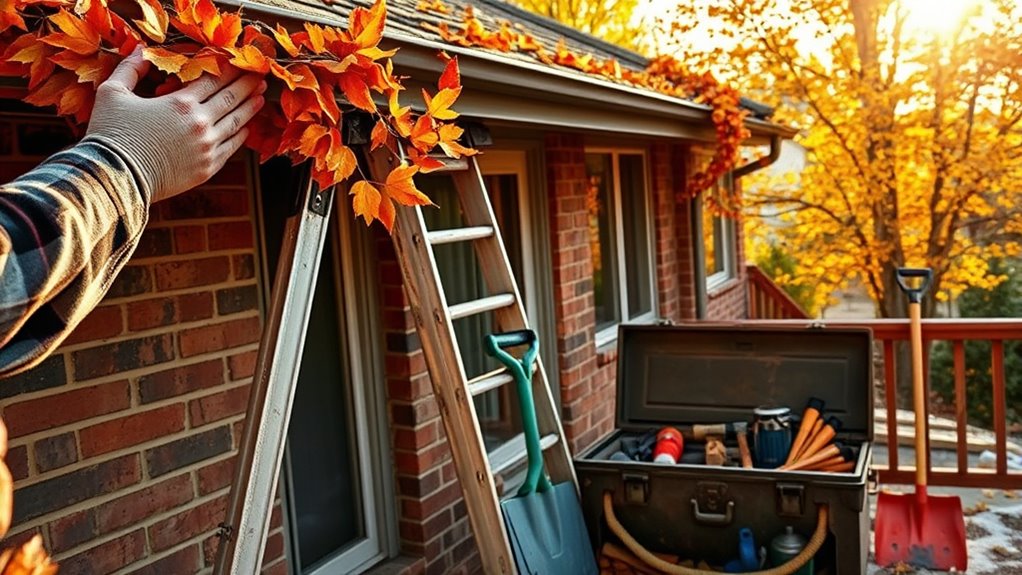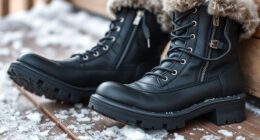To prep your home for winter, start by cleaning your gutters to prevent water damage and inspect your chimney for creosote buildup or cracks. Seal gaps around windows and doors, boost insulation, and service your heating system for efficiency. Don’t forget to drain outdoor hoses and store tools properly. Taking these steps now helps protect your home and saves money later. Continue to uncover more essential tasks for a cozy, secure winter season.
Key Takeaways
- Clean and inspect gutters to prevent clogs and water damage during winter storms.
- Schedule chimney inspection and repair any cracks or blockages for safe fireplace use.
- Seal windows and doors, and insulate attics and basements to improve energy efficiency.
- Drain outdoor hoses, cover outdoor furniture, and trim branches to protect property from winter elements.
- Service heating systems and replace filters to ensure reliable indoor warmth throughout the season.

Have you completed your fall home maintenance checklist yet? If not, now’s the time to get started, especially with winter just around the corner. One of the most critical tasks is ensuring your gutters are clean and free of debris. Gutter cleaning might seem like a simple chore, but it plays a essential role in protecting your home from water damage. When leaves, twigs, and dirt accumulate in your gutters, they can clog the system, causing water to overflow during heavy rains or snowmelt. This overflow can seep into your foundation, damage your siding, or create water pooling around your basement. Consequently, inspecting and cleaning your gutters now helps prevent costly repairs later and guarantees your drainage system functions properly during winter storms.
Alongside gutter cleaning, a thorough chimney inspection is necessary. As temperatures drop, you’ll likely start using your fireplace or wood stove more frequently. Before lighting that first fire, it’s imperative to have a professional chimney inspection. A qualified technician will check for creosote buildup, blockages, cracks, or structural issues that could pose fire hazards or indoor air quality problems. Regular chimney inspections also help identify signs of wear or damage that might not be obvious, such as damaged mortar or leaks. Addressing these issues now can prevent dangerous chimney fires and ensure your heating system operates efficiently throughout the cold months. Remember, a well-maintained chimney improves safety and keeps your home warm and cozy when it’s cold outside.
While focusing on gutters and chimneys, don’t forget other key fall maintenance tasks. Seal any gaps or cracks around windows and doors to keep cold drafts out and increase energy efficiency. Check your insulation levels in attics and basements, making sure they’re sufficient for winter. Also, service your heating systems by replacing filters, inspecting vents, and scheduling professional tune-ups if needed. These steps help your home retain heat better and reduce energy bills.
In addition, considering the luxurious features available for tiny houses can help you optimize your space for winter comfort and efficiency. Finally, make sure your outdoor spaces are prepared for winter as well. Rake fallen leaves, trim branches that could fall on your roof or power lines, and drain outdoor hoses to prevent freezing and damage. Cover or store outdoor furniture and gardening tools to protect them from the elements. By ticking off these tasks now, you create a safer, more energy-efficient home that’s ready to face the winter months with minimal stress. Taking the time for extensive fall home maintenance ensures your house stays protected, comfortable, and ready for whatever winter throws your way.
Frequently Asked Questions
When Should I Start Preparing My Home for Winter?
You should start preparing your home for winter in early fall, typically around September or October. This timing allows for seasonal planning and makes sure you address potential issues before cold weather hits. By tackling tasks like sealing drafts, inspecting the heating system, and cleaning gutters now, you prevent costly repairs later. Starting early gives you peace of mind and ensures your home stays cozy throughout winter’s worst weather.
How Often Should I Check My Heating System in Fall?
Think of your heating system as the beating heart of your home; you don’t want it to skip a beat. You should check your heating system at least once in fall, ideally before the cold hits. A fall HVAC check guarantees it’s running smoothly and efficiently. Regular heating system maintenance keeps your home warm and safe, preventing unexpected breakdowns when you need heat most.
What Are Signs My Roof Needs Repair Before Winter?
You should check your roof for signs like roof leaks or missing shingles before winter. Roof leaks may appear as water stains on your ceilings or walls, while missing shingles can be seen during a visual inspection. If you notice either issue, address them promptly to prevent further damage. Falling shingles or leaks indicate your roof needs repairs to withstand winter weather, so don’t delay in calling a professional if needed.
How Can I Prevent Ice Dams on My Roof?
Prevent ice dams on your roof like a shield defending your home by ensuring proper roof ventilation. Good ventilation keeps the attic cold, reducing snow melting and refreezing at the eaves. To improve ice dam prevention, seal any air leaks and add insulation where needed. These steps help maintain a consistent roof temperature, preventing ice dams and protecting your home from water damage during winter.
Are There Eco-Friendly Ways to Insulate My Home?
You can insulate your home eco-friendly by choosing sustainable insulation options like cellulose made from recycled paper, sheep’s wool, or cork. These eco-friendly materials provide excellent insulation while reducing environmental impact. You should also look for products with low embodied energy and certification like GreenGuard. Proper installation guarantees maximum efficiency, saving energy and lowering your carbon footprint. Switching to sustainable insulation is an easy way to make your home more eco-conscious this winter.
Conclusion
By tackling this fall home maintenance checklist, you’re laying a sturdy foundation to weather winter’s chill. Think of your home as a shield, ready to stand strong against the cold, wind, and snow. When you complete these tasks, you’re wrapping your house in a warm blanket of preparedness. With each chore crossed off, you’re not just ready for winter—you’re turning your home into a fortress that stands tall and resilient, no matter what the season brings.









